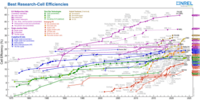
Photo from wikipedia
A metamaterial-based energy harvesting structure for harvesting 0.90 GHz, 1.80 GHz, 2.60 GHz GSM bands and a 5.80 GHz Wi-Fi frequency band is numerically and experimentally demonstrated. The metamaterial unit cell consists of four… Click to show full abstract
A metamaterial-based energy harvesting structure for harvesting 0.90 GHz, 1.80 GHz, 2.60 GHz GSM bands and a 5.80 GHz Wi-Fi frequency band is numerically and experimentally demonstrated. The metamaterial unit cell consists of four nested split-ring resonators (SRRs) interconnected on their split parts. Three resistors are used to harvest electromagnetic waves, which are sent to the structure with the electric field vector polarized in parallel to the gap of the SRRs. Under normal excitation, electromagnetic energy harvesting efficiencies are found to be 85.7%, 82.0%, 80.4% and 69.8% at 0.90 GHz, 1.80 GHz, 2.60 GHz and 5.80 GHz, respectively, by numerical analyses. Surface current distributions are utilized to gain insight into the relation between the harvesting frequencies and the structure. The effect of incidence angle upon harvesting efficiencies shows that the increase of absolute angle of incidence has different consequences for each harvesting band. The harvesting efficiency is increased to be as high as approximately 90% at 2.60 GHz and 5.80 GHz when the incidence angle is increased to 30°. The metamaterial sample is fabricated by conventional photolithography and the measured results in absorption performance are found to be in reasonable agreement with the numerical results. Moreover, it is demonstrated that the proposed metamaterial harvester structure has flexibility in terms of tailoring the harvesting frequencies and multi-band harvesting with more than four bands.
Journal Title: Journal of Electronic Materials
Year Published: 2019
Link to full text (if available)
Share on Social Media: Sign Up to like & get
recommendations!